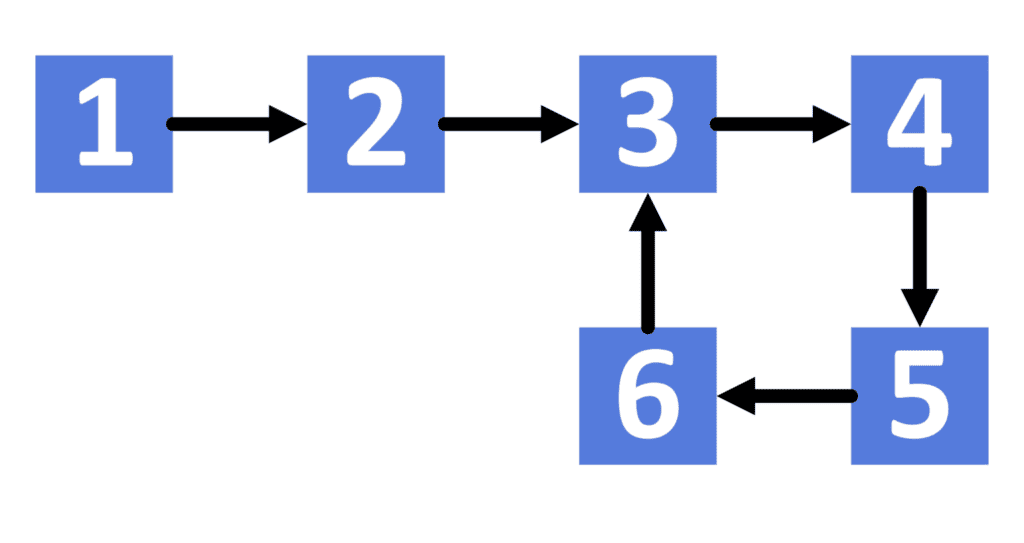1. 概述
在本教程中,我们将讨论如何检测一个单链表中是否存在环,并找出环的起始节点。
首先,我们将介绍问题的基本概念,然后讲解两种主流解决方案。接着,我们分析两种特殊情况,并说明如何调整其中一种方法来处理它们。
最后,我们会对所有方法进行对比,帮助你根据实际场景选择最合适的方式。
2. 问题定义
假设我们有一个单链表 A,它包含 n 个节点。我们的目标是判断该链表是否包含环(cycle),如果存在环,则找出环的起始节点。
什么是链表中的环?
链表由若干节点组成,每个节点指向下一个节点。当最后一个节点不再指向 null,而是指向链表中的某个已有节点时,就形成了环。
如下图所示:

需要注意:
- 一个链表中只能存在一个环。
- 环的成因一定是最后一个节点指向了链表中已有的某个节点。
3. 标记访问法(Visited Approach)
3.1 基本思路
在无环链表中,我们可以使用 while 循环进行遍历:
Node current = head;
while (current != null) {
// process current node
current = current.next;
}
但如果链表中存在环,这段代码会陷入死循环。
解决方法:
为每个节点添加一个 visited 标志位,记录是否已被访问过。
3.2 实现代码
public Node detectCycleWithVisited(Node head) {
Node current = head;
while (current != null && !current.visited) {
current.visited = true;
current = current.next;
}
return current; // 若为 null 表示无环
}
✅ 优点:
- 实现简单,逻辑清晰。
❌ 缺点:
- 需要修改节点结构,添加 visited 字段。
- 若链表不可变(如只读),此方法不适用。
⚠️ 注意:
遍历结束后应将所有节点的 visited 标志位重置为 false,避免影响其他逻辑。
4. 特殊情况处理
4.1 小范围整型 ID(Small Integer IDs)
如果每个节点有一个整型 ID,且其取值范围较小(如 [0, MaxVal]),我们可以使用一个布尔数组来记录访问状态:
public Node detectCycleWithSmallIds(Node head, int maxVal) {
boolean[] visited = new boolean[maxVal + 1];
Node current = head;
while (current != null) {
if (visited[current.id]) {
return current;
}
visited[current.id] = true;
current = current.next;
}
return null;
}
✅ 优点:
- 不需要修改节点结构。
- 时间复杂度 O(n)
❌ 缺点:
- 空间复杂度 O(MaxVal),若 ID 范围大则不适用。
4.2 使用 TreeSet(TreeSet Approach)
当 ID 不是整数或值域很大时,可以使用 TreeSet 或 HashSet 来记录已访问节点:
public Node detectCycleWithTreeSet(Node head) {
Set<Integer> visited = new TreeSet<>();
Node current = head;
while (current != null) {
if (visited.contains(current.id)) {
return current;
}
visited.add(current.id);
current = current.next;
}
return null;
}
✅ 优点:
- 通用性强,适用于任意类型 ID(只要可比较/可哈希)。
❌ 缺点:
- 时间复杂度 O(n log n)
- 空间复杂度 O(n)
5. 双指针法(Two-Pointers Approach)
5.1 基本思路
使用两个指针 slow 和 fast:
- slow 每次移动 1 步
- fast 每次移动 2 步
如果链表中存在环,两个指针最终会相遇。
步骤如下:
- 判断是否存在环
- 计算环的长度 m
- 找出环的起始节点
5.2 实现代码
public Node detectCycleWithTwoPointers(Node head) {
Node slow = head, fast = head;
boolean hasCycle = false;
// Step 1: Check for cycle
while (fast != null && fast.next != null) {
slow = slow.next;
fast = fast.next.next;
if (slow == fast) {
hasCycle = true;
break;
}
}
if (!hasCycle) return null;
// Step 2: Calculate cycle length
int m = 0;
do {
slow = slow.next;
m++;
} while (slow != fast);
// Step 3: Find start of cycle
slow = head;
fast = head;
for (int i = 0; i < m; i++) {
fast = fast.next;
}
while (slow != fast) {
slow = slow.next;
fast = fast.next;
}
return slow;
}
✅ 优点:
- 不需要额外空间(O(1))
- 不修改原始链表结构
❌ 缺点:
- 逻辑较复杂,需要理解数学原理
5.3 原理证明(简要)
- fast 指针速度是 slow 的两倍
- 一旦进入环,fast 会“追上” slow
- 两者相遇后,通过调整指针位置可以找到环的起点
6. 方法对比
| 方法 | 时间复杂度 | 空间复杂度 | 是否修改结构 | 适用场景 |
|---|---|---|---|---|
| Visited Approach | O(n) | O(n) | ✅ 是 | 可修改节点结构 |
| Small Integer IDs | O(n) | O(MaxVal) | ❌ 否 | ID 范围小 |
| TreeSet Approach | O(n log n) | O(n) | ❌ 否 | 通用 |
| Two-Pointers Approach | O(n) | O(1) | ❌ 否 | 最通用 |
7. 总结
在检测链表环的问题中,我们有多种解决方案:
- Visited Approach:实现简单,但需要修改节点结构。
- Small Integer IDs:适合 ID 范围小的场景。
- TreeSet / HashSet Approach:通用但效率较低。
- Two-Pointers Approach:最推荐的通用解法,空间效率高,无需修改结构。
✅ 最佳实践建议:
- 若无法修改结构,优先使用双指针法。
- 若 ID 有特殊限制,可考虑小整型或集合法。
- 只有在允许修改结构时才使用 Visited 法。
掌握这些方法后,在实际开发中遇到链表环的问题时就能游刃有余了。